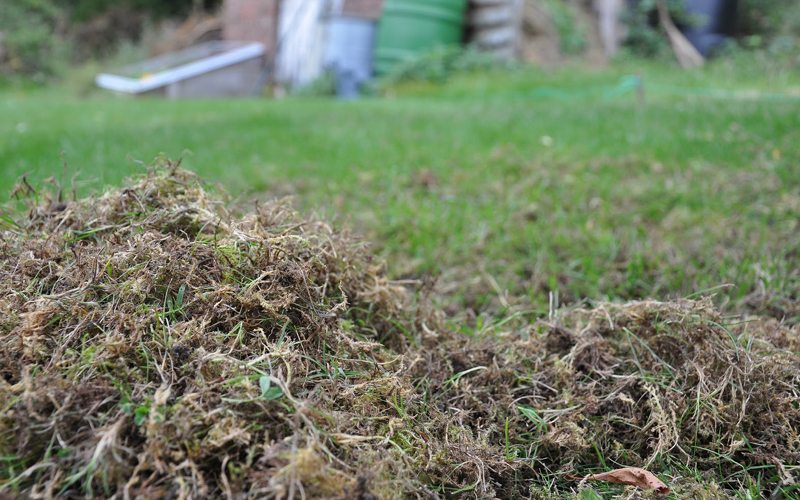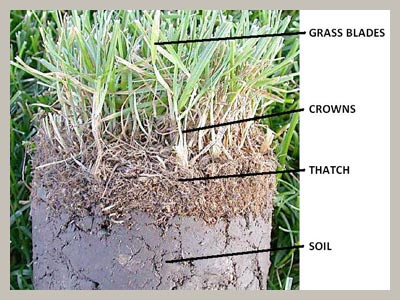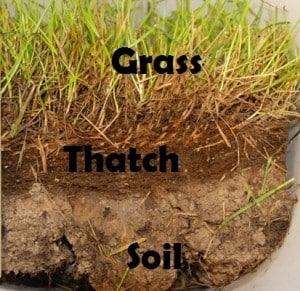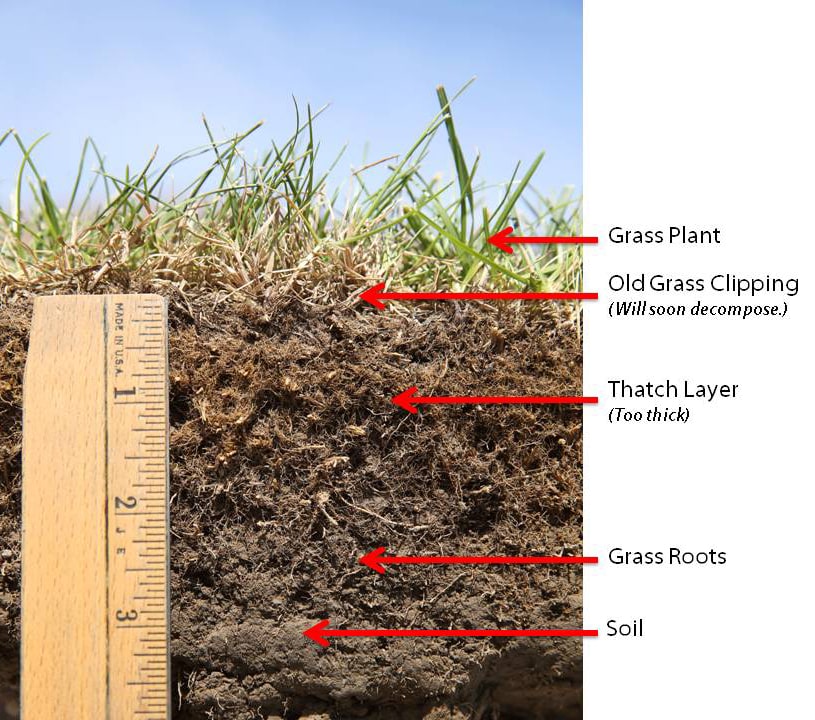

As you walk over a lawn, you may notice that is feels quite spongy to walk on. If you take a closer look, you may also notice that you can’t see the soil level because it is covered by a layer of fibrous matter that intertwines between the grass plants. This fibrous matter is known as thatch.
What is Thatch?
Thatch is the fibrous layer of organic material that forms on the surface of most domestic lawns. Thatch is mostly made of dead grass clippings, leaves and other garden matter.


How does thatch form?
The organic fibres weave together and build up on the surface of the lawn, forming what’s referred to as the thatch layer.
As we walk over the lawn and/or mow the lawn, we compress this thatch layer down. As more thatch forms on the top, the layer becomes deeper and continues to compact.
Thatch is very much like a compost heap. It is a mixture of decompostable material such as leaves, grass clippings, pieces of bark and wood from surrounding trees. The key to efficiently turning garden waste into fresh soil on a compost heap is to maintain the air and water flow throughout the heap. Additional nutrients added to the heap will also aid the decomposing process.
The thatch layer on a lawn wants to decompose naturally, but several factors will prevent it from doing so. As the fibres compress down, and the weave becomes tighter, there is a lack of air and water flowing through it. Unless the thatch layer is managed properly, it will become harder for it to decompose naturally. It will continue to get deeper, and become more of a problem.
Thatch forms quicker in gardens with high fences, trees, and buildings that reduce the natural airflow over the lawn. Excessive thatch causes the soil underneath the lawn to become dry and compact, further reducing the air and waterflow around the thatch layer.
Why is thatch a problem?
Thatch on a lawn acts like a sponge. It absorbs water and will hold on to the water, rather than letting it drain through to the soil and the root zone. Its weaved formation will also severely slow down the flow of air to the root zone.
The deeper the thatch layer, the drier the soil underneath. Dry soils will beomce compact. The more compact soil becomes, the harder it is for water to penetrate it, and the cycle of thatch and soil compaction will continue to get worse.


Above: This examples shows how the soil underneath a thick layer of thatch can become dry and compact.
As the soil remains dry, the grass plants no longer find it useful to grow roots into the soil. Rather than attempting to absorb water from the soil, the grass plants start to grow their roots into the thatch layer. Thatch is a bad medium for grass plants to grow. It offers very little physical support, and the flow of air, water and nutrients is no longer balanced, causing major deficiency problems.


Above: The thatch layer on this lawn is far too deep. The roots of the grass plants are now only using the thatch as its growing medium. Notice how unhealthy the grass plants are at the surface of the lawn.
During the spring and the summer, water needs to penetrate the soil level and reach the roots of the grass plants. However, when it rains, the thatch acts like a sponge by absorbing the water. Then when the weather changes and the sun comes out, the rainwater is evaporated quickly, without giving it a chance to reach the soil level.
Thatch creates a good home for moss and fungal diseases
Moss and fungal diseases both prefer a much more still environment. By “still”, we refer to a reduced movement of air and water. In the thatch layer, there is a severely reduced amount of movement of these vital elements. As the thatch layer becomes more and more compact, this imbalance of the vital elements starts to create an environment that is more favourable to moss and fungal diseases.
Moss doesn’t require soil to grow in. Instead, it prefers a more porous environment for it to anchor itself into. Thatch provides this near perfect environment.
Thatch reduces the effect of the fertilisers we apply to your lawn
When we apply fertilisers to your lawn, we want them to be as effective as possible. The fertilisers we apply are designed to reach the surface of the soil.
Thatch prevents these fertiliser prills reaching the surface of the soil, reducing their effectiveness.
How do we manage a layer of thatch?
We would recommend carrying out the following Booster treatments to reduce and control thatch:
a. Scarification
b. Hollow-tine aeration
